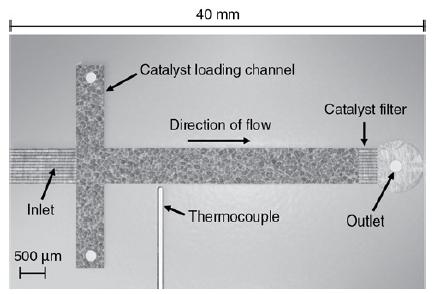A microreactor from the MIT group similar to the one shown in Figure P5-21B was used to
Question:
A microreactor from the MIT group similar to the one shown in Figure P5-21B was used to produce phosgene in the gas phase.
A figure depicts a Microreactor of size 40mm. At first, the microreactor has an inlet. A catalyst loading channel is attached to the inlet and the direction of flow is indicated towards the right of the reactor. At last, there is a catalyst filter that filters the input from the channel and passes the final output to the outlet. There is a thermocouple noted at the bottom of the reactor. CO + Cl2 → COCl2
A + B → C
The microreactor is 20 mm long, 500 μm in diameter, and packed with catalyst particles 35 μm in diameter. The entering partial pressure of A is 231 kPa (2.29 atm), and the entering flow to each microreactor is equimolar. The molar flow rate of CO is 2 × 10–5 mol/s and the volumetric flow is 2.83 × 10–7 m3/s. The weight of catalyst in one microreactor: W = 3.5 × 10–6 kg. The reactor is kept iso-thermal at 120°C. Because the catalyst is also slightly different than the one in Figure P5-21B, the rate law is different as well:
−rA′=kACACB
Additional information:
a. Plot the molar flow rates FA, FB, and FC, the conversion X, and pressure ratio p along the length (i.e., catalyst weight, W) of the reactor.
b. Calculate the number of microreactors in parallel needed to produce 10000 kg/year phosgene.
c. Repeat part (a) for the case when the catalyst weight remains the same but the particle diameter is cut in half. If possible, compare your answer with part (a) and describe what you find, noting anything unusual.
d. How would your answers to part (a) change if the reaction were reversible with KC = 0.4 dm3/mol? Describe what you find.
Step by Step Answer:






